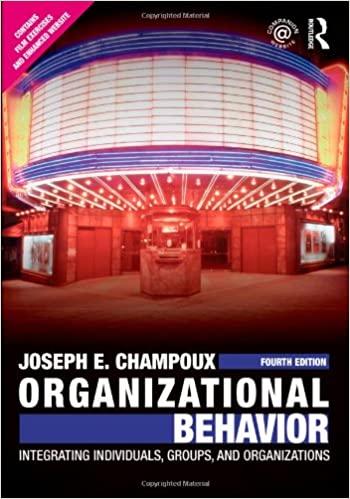Discuss the three dimensions in Fiedlers contingency theory of leadership. Try to identify an example from your
Question:
Discuss the three dimensions in Fiedler’s contingency theory of leadership. Try to identify an example from your experiences of one situation shown in Figure 12.1. Did the leader in that situation behave as predicted by the theory? If not, did you perceive the leader as effective or ineffective? Discuss how the theory explains why the leader was effective or ineffective.
Fiedler’s Contingency Theory of Leadership
Fred E. Fiedler studied leadership in widely varying groups, such as manufacturing groups, boards of directors, managers, and military combat teams. His work built a contingency theory of leadership that considered the characteristics of the leader and the characteristics of the situation.
Fiedler’s theory assumes leaders are predisposed to a particular set of leader behaviors. Leaders are either task-oriented or relationship-oriented. Taskoriented leaders are directive, structure situations, set deadlines, and make task assignments. Relationship-oriented leaders are not strongly directive, focus on people, and desire positive social interaction. Although the two types of leaders are similar to the behavioral dimensions discussed earlier, an important distinction exists between Fiedler’s contingency theory and the behavioral theories. Fiedler’s theory assumes that it is hard to change a predisposition to a particular leadership style; the behavioral theories assume a leader has behavior choices.
Situations differ in how favorable they are for a leader to influence subordinates based on variations in the three dimensions of leader–member relations, task structure, and position power. Leader–member relations describe the quality of the relationship between subordinates and the leader. This dimension includes the amount of trust between the leader and subordinates and whether the leader is liked and respected by the subordinates. Task structure describes the extent to which the work is well defined and stan dardized or ambiguous and vague. When task structure is high, the work is predictable and can be planned. Low task structure creates an ambiguous situation with changing circumstances and unpredictable events. Position power refers to the leader’s formal authority. A situation with high position power lets the leader hire people and directly reward or punish behavior. A leader with low position power does not have the authority for such actions. In the latter situation, policies might constrain the leader from using any rewards or punishments.
The three dimensions help classify situations according to how favorable the situation is for the leader’s influence. Figure 12.1 shows a classification based on a dichotomy of each dimension. Favorable situations allow high leader influence; unfavorable situations allow little leader influence. Fiedler’s contingency theory makes two broad recommendations about leadership: Taskoriented leaders are more effective in highly favorable or highly unfavorable situations, and relationship-oriented leaders are more effective in situations between those two extremes. These recommendations have received strong empirical support.
Fiedler did not think organizations could easily and reliably select leaders to match the situations in the organization. He also was not optimistic about the effectiveness of leadership training designed to change leaders. He argued strongly that the situation had to be changed to fit a leader’s predispositions, that is, “‘engineer’ the job to fit the [leader].”
Alternatively, the leader can be trained to understand her approach to leadership. The leader learns ways to change the situation to be successful.
The relationship between a successful leader type and the characteristics of the situation is logical and easy to understand in some situations, but is less clear in others. For example, in the first situation on the far left of the figure, the leader is well liked, and the task is clear. Focusing on the task in this situation might seem right. The situation on the far right also makes sense. The leader has nothing to lose by being task-oriented if everything in the situation already is unfavorable. What is less clear is why a relationship-oriented leader is right for some situations shown for that orientation. A relationship-oriented leader will have difficulty being effective in a group where she is disliked. This type of leader also is nondirective and possibly lets the structure of the task affect subordinate behavior.
Step by Step Answer:

Organizational Behavior Integrating Individuals Groups And Organizations
ISBN: 9780415804646
4th Edition
Authors: Joseph E. Champoux





